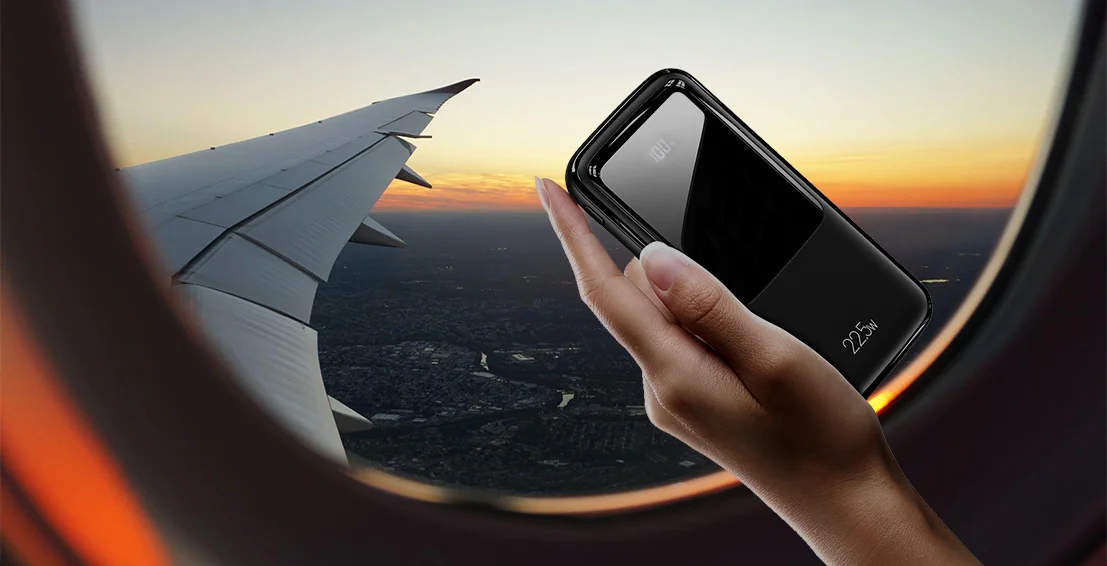Какие внешние аккумуляторы можно брать в самолет?
Какие внешние аккумуляторы разрешены в самолете?

It’s hard to know what, exactly, you can take on a plane, especially when it comes to power banks.
You can’t bring just any old power bank on the plane. Here, at TVCMALL, we have all the intel you need to know which power banks are allowed on a plane.
Why Are Power Banks Restricted on Planes?
In 2010, a UPS plane crashed in the United Emirates. The investigation deemed that the cargo of lithium batteries that caught on fire was to blame. The crash highlighted the dangers of lithium batteries and spurred the regulations we have today.
Lithium batteries are hazardous because of highly flammable materials that, when ignited, burn intensely and quickly in a process known as “thermal runaway.” Luckily, lithium batteries rarely catch fire.
All the same, a fire resulting from a lithium battery can quickly get out of control, which is why the Federal Aviation Administration (FAA) regulates lithium batteries on planes, including those used in power banks. If you’re on a European flight, you’ll need to refer to the European Union Aviation Safety Agency’s (EASA) regarding power banks on flights.
EASA Regulations for Power Banks on European Flights
The European Union Aviation Safety Agency’s (EASA) rules regarding power banks on planes are similar to those of the TSA and FAA. You must store your power bank in your carry-on bag rather than your checked luggage. And you may not bring a power bank with more than 100 watt-hours without express permission from the airline.
However, unlike the FAA, the EASA explicitly forbids using a power bank to charge your devices while on the plane.
FAA Regulations Regarding Power Banks
The FAA’s first rule on power banks is you must pack your power bank in your carry-on bag. That’s easy to comply with because, after all, you’ll need your power bank on the plane to binge-watch your favorite episodes of Breaking Bad.
The FAA’s next rule on power banks on planes is a bit sketchier to understand. It states each power bank must not be over 100 watt-hours (Wh). That may seem straightforward until you realize most product descriptions of power banks don’t list watt-hours.
Understanding Your Power Bank’s Capacity
Power bank product descriptions typically list two other metrics indicating their capacity: milliamp hours (mAh) and voltage (v). Don’t panic, though, because you can easily use those two numbers to calculate watt-hours.
Think of milliamp hours as the size of a gas tank when it comes to power banks. The higher the milliamp hours, the longer you can go before you need to charge the power bank. Along those same lines, a power bank with a high milliamp-hours capacity will be able to charge multiple devices (or the same device multiple times) before needing to be recharged.
Voltage indicates the amount of power that travels from the power bank to the device. A higher voltage means that the power bank will charge the device more quickly.
When you know the milliamp hours and voltage of your power bank, you can calculate its watt-hours using the following equation:
(mAh/1,000) * v = Wh
For example, let’s say you have a power bank with a capacity of 20,000 mAh and 5 v. The equation would read as follows:
(20,000/1,000) * 5 = Wh
When you divide 20,000 by 1,000, you get 20. Then, when you multiply 20 by 5, you 100 Wh.
Power Banks Perfect for Air Travel
Save the math for counting Euros when buying macarons from a French bakery. At TVCMALL, we have your energy needs covered with a list of power banks you can tank on a plane.
5,000mAh Mini Purple Power Bank with Digital Display. This little power bank is small enough to fit in your shirt pocket but powerful enough to charge your phone quickly. And with the digital display, you won’t need to guess how much power is left.
5,000mAh Magnetic Power Bank for Samsung Galaxy Watch and More. Charge multiple devices at one time, including your Galaxy Watch, with this magnetic power bank with charging ports.
10,000mAh Power Bank with Built-In Wall Adapter. You’ll have one less cord to carry around with this power bank that has a built-in wall adapter.
20,000mAh Power Bank with Built-In Cables. Boost your charging capacity with this power bank with 74Wh. It’s the only power bank you’ll need to get from New York to Paris.
Check with Your Airline Before Carrying a Power Bank on a Plane
In addition to government regulations, many airlines have additional rules regarding power banks. Always call ahead before carrying or using a power bank on a plane. Also, many planes now have options for charging your devices in flight with USB or other outlets.
FAQs About Carrying a Power Bank on Planes
Is it okay to bring a power bank on a plane?
European and U.S. government regulations allow a power bank with a capacity of up to 100Wh on flights. However, always call the airline for information on additional rules regarding power banks on flights.
Can I bring a power bank on an international flight?
Most international flights allow power banks with a capacity of up to 100Wh in carry-on luggage. However, always call the airlines before arriving for your flight.
How do you take a power bank on a plane?
Always pack your power banks in your carry-on bag, never in your checked luggage. Always ensure your power bank is free of damage or defects.
Can I take more than one power bank on a plane?
Yes, you can take more than one power bank on a plane. Just make sure none of your power banks are larger than 100Wh. Always call the airline for more specific rules about power banks on planes.
Fly Confidently with Power Banks Allowed On Planes
If globetrotting makes you THRIVE, our planet has 67 million square miles of land for travel lovers like you to roam. However, you can’t Instagram your epic adventures without a reliable power bank you can take on a plane.
Lithium batteries are a small, but significant, fire risk. And for that reason, the TSA won’t allow power banks in checked luggage. Also, any power bank you put in your carry-on bag must have a capacity of 100Wh or less. You can always pack more than one power bank if you need more energy than that.
So, take as many devices as you need. But make sure you call the airline to verify their rules about taking power banks on planes.
Оставить комментарий
Ваш адрес электронной почты не будет опубликован. Обязательные поля помечены *
Будьте в курсе с оптовыми продажами TVCMALL
Подпишитесь бесплатно на наш блог и получайте экспертные советы, отраслевые идеи и лучшие оптовые предложения. Увеличьте свои продажи с TVCMALL уже сегодня!



